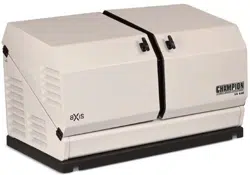Loading ...
Loading ...
Loading ...

aXis CONTROLLER HOME STANDBY GENERATOR
INSTALLATION
19
Champion HSB units have been run and tested at the factory prior
to shipment. They do not require any type of break-in period.
Site Selection, Preparation and Placement
These items are important to the overall performance of the HSB
generator. Many items covered in this section are not optional and
are requirements under Federal, State and Local codes. As with
all generators, your generator must be installed in accordance
with current NFPA-37, NFPA 54, NFPA 58 and NFPA-70 standards.
Contact your local electrical inspector or city hall to insure you
are aware of all codes and regulations. Install the equipment in
compliance with the National Electric Code (NEC). For Canada
installations, refer to Canadian Electrical Code (CEC). Contact your
natural gas supplier to verify that increased BTU gas demand can
be handled with the existing NG meter. The same should done for
LPG fueled generators. This generator in the enclosure is designed
to be installed outdoors only.
Champion HSB units are run and tested at the factory prior to
being shipped. They do not require any type of break-in period.
SUGGESTED SITE SELECTION
The installation of the HSB must comply strictly with NFPA 37,
NFPA 54, NFPA 58 and NFPA 70 standards.
Always install your generator within 20 feet of the NG meter, the
closer the better. This will reduce expensive costs of running fuel
line. In some cases longer runs of fuel line, when not properly
sized may cause inadequate fuel delivery. This could result in
poor starting, lower outputs and diminished overall performance
of the unit. The Champion HSB is shipped from the factory set
up for natural gas (NG) fuel. The HSB can be converted to LPG
if required. Orifices in the master mixer assembly (carburetor)
MUST be changed. The LPG orifices are shipped with the unit and
include installation instructions.
Install the unit in a location where the sump pump discharge,
rain gutter downspouts, roof run off, landscape irrigation, natural
ponding or water sprinklers will not flood the unit or spray the
enclosure entering any inlet or outlet opens.
Position the unit in an area where prevailing winds will carry
the exhaust gas away from any potentially occupied building or
structure.
Install the unit where leaves, grass, snow, ect., will not obstruct
air inlet and outlet openings. If prevailing winds cause blowing or
drifting, you may consider building a windbreak, planting trees or
shrubs within the guidelines and codes applicable.
Watch out for roof overhangs. Snow, ice or rain shouldn’t be
permitted to accumulate on the roof and then cascade onto the
unit.
DANGER
Engine exhaust from the unit is hot, poisonous and dangerous.
Exhaust must be allowed to dissipate into a free air zone as
listed in the applicable codes with no obstructions.
Direct the HSB exhaust away from or parallel to the building or
structure. DO NOT direct the HSB exhaust toward a potentially
occupied building, structure, windows, doors, ventilation intakes,
soffit vents, crawl spaces, open garage doors or other openings
where exhaust gas could accumulate and enter inside or be drawn
into potentially occupied buildings or structures.
Install the unit on higher ground where water levels will not rise
and endanger it. This unit shouldn’t be operated in standing water.
DO NOT place HSB waterproof enclosure under a deck or other
type of structure that may confine or restrict airflow. Operate
HSB only outdoors, where adequate ventilation and air movement
is available. Avoid installations under decks, inside garages or
carports, in basements, along home exterior within 5 feet (1.5m)
of home vent, roof overhang vents, a window that can be opened,
or other such home invasion points. Use the same precautions
when installing HSB at property line, close to a neighbor’s home,
or any building or structure that houses animals.
DANGER
Running engines give off carbon monoxide, an odorless,
colorless, invisible, poison gas.
Breathing carbon monoxide will cause fatigue, headache,
dizziness, vomiting and in prolonged conditions, even death.
Carbon monoxide detectors MUST be installed and maintained
indoors according to the manufacturer’s instructions/
recommendations. Smoke alarms cannot detect carbon
monoxide gas.
The back of the HSB locates the fuel and wire entry points. When
placement/mounting is done this side generally faces the closest
point to each of those sources.
It is always recommended to prepare a drawing showing location
of HSB, typical gas utility approach, circuit connections and full
load connections.
Similar considerations should be given to the location of the ATS
(automatic transfer switch) in relationship to the HSB generator.
The closer to both the fuel meter and the main utility panel
the better. The key point here is, the closer to fuel meter is the
suggested direction to go, wire is cheaper to run and more flexible.
Loading ...
Loading ...
Loading ...
